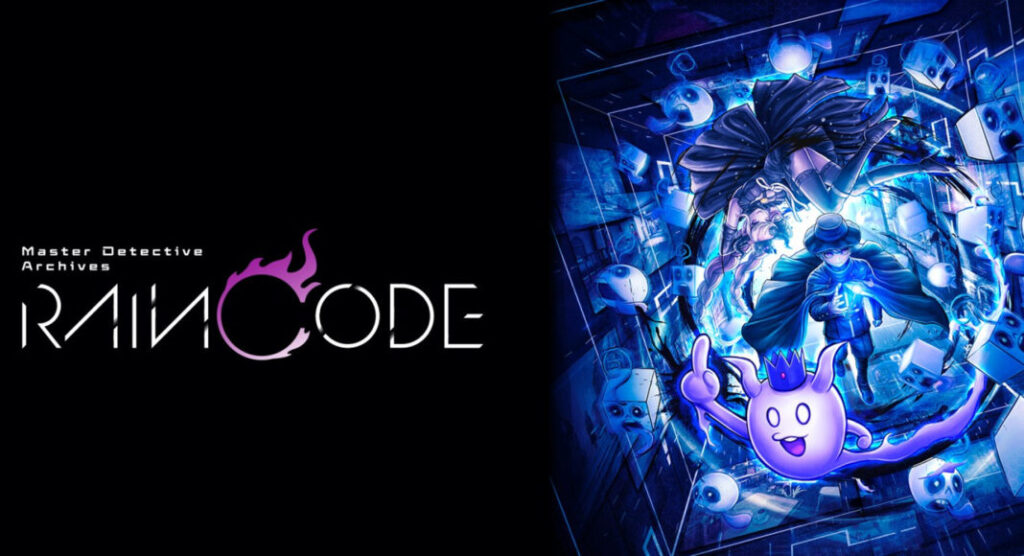
Developer: Too Kyo
Publisher: Spike Chunsoft
Platform: Switch
Tested on: Switch
Master Detective Archives: Rain Code – Review
Back in 2017, several members of the team behind Spike Chunsoft’s Danganronpa series left the company to form Too Kyo Games. Their first two titles, FMV Death Come True and the excellent World’s End Club showed promise, but were quite different from Danganronpa. It seems that with their third title, Master Detective Archives: Rain Code, the team is returning to their roots, at least in terms of atmosphere. They’ve even teamed up with Spike Chunsoft again to handle publishing duties. Given that we adore the Danganronpa games, we were more than eager to jump into Rain Code to find out if this spiritual successor can live up to its illustrious predecessors.
Story
Trying to summarise Rain Code’s story is almost as much of a challenge as the game itself. There are several layers at play here and head writer Kazutaka Kodaka loves misdirecting the player. The game features two main plot lines. One of these involves a conflict between the shady Amaterasu Corporation, who have turned the city of Kanai Ward into an autonomous zone under their control. This isn’t to the liking of the government, who have asked the World Detective Organization (WDO) to investigate Amaterasu’s plans. This conflict acts as the overarching plot for the main storyline: protagonist Yuma Kokohead, a young Master Detective, is suffering from amnesia. This is a side-effect of a pact he has made with the Death God Shinigami. In exchange for Kokohead’s memories, Shinigami accepts him as her master, giving the detective access to her mystery-solving powers. Kokohead finds himself unwittingly thrown into the Amaterasu case, alongside Shinigami and a group of other Master Detectives, each with their own unique Forte power. Our unlikely protagonist duo must tackle a series of increasingly complex cases that are all tied to the Amaterasu-WDO conflict, with Kokohead trying to piece together his identity in the process.
We’ll try not to spoil too much, but if you’re a fan of the Danganronpa, Ace Attorney, or Persona series, then we expect Rain Code‘s story to be right up your alley. For our review, we decided to stick to first-case screenshots only, but even so, there’s a good chance that you’ll figure out some things from what’s visible here. The mysteries are well-written, and although some of the characters you encounter are fairly two-dimensional, this has more to do with just how many of them were crammed into the game. Having the supporting cast embody tropes makes it easy for the player to understand what makes characters tick without having to spend too much time on their backstories. The central relationship between Shinigami and Kokohead on the other hand is interesting, even if we could have done with less innuendo on Shinigami’s behalf.
Graphics
Nowhere are Rain Code’s roots as visible as in its aesthetics. The character designs make use of the same art style as the Danganronpa series, with the exception of Shinigami’s ghost form, which looks more like a Luigi’s Mansion reject than Danganronpa’s iconic Monokuma. Her more humanoid form sticks closer to the established style, however. The main difference is that the majority of Rain Code’s visuals are rendered in 3D rather than Danganronpa’s blend of 2D characters in a 3D environment. We should note that although we absolutely loved Rain Code’s art direction, the visual performance left some things to be desired, which is a shame because this is a Switch exclusive and we’ve seen both Too Kyo and Spike Chunsoft utilize the console’s strengths in the past. The game looks rather fuzzy, especially in docked mode. Admittedly, Rain Code keeps up a steady frame rate, but we couldn’t help but shake the feeling that it could and should have looked a lot crisper.
Sound
With the cast boasting established names like Loop8’s Xanthe Huynh and Live A Live’s Brent Mukai, it shouldn’t come as a surprise that the voice cast’s performances are fantastic. While the game has both English and Japanese language options, this is one of those rare cases where we felt like the English cast does such a stellar job that it’s actually superior to the original Japanese voices. Likewise, composer Masafumi Takada delivers an outstanding set of music tracks that underscore the fast-paced gameplay when necessary and which also sets the right mysterious atmosphere when required. If there’s one issue we had with Rain Code’s soundscape, it’s that there is an issue where the English audio didn’t always synchronize with characters talking on-screen, which was distracting.
Gameplay
We’ve played plenty of mystery games in the past, and we figured Rain Code would play out similarly to games like Famicom Detective Club or Hermitage, but things turned out to be quite different. The game is structured similarly to the Ace Attorney series. The interconnected story is told through a series of cases, and each case has you investigate a mystery, gather evidence and clues, and talk to witnesses, before moving on to a phase where you make connections and present gathered evidence in order to uncover the truth. It’s in this latter half where Rain Code goes off the rails, albeit in a good way. Sticking with our comparison to Ace Attorney, that latter half would line up with the courtroom gameplay. However, in Rain Code, instead of heading to a courtroom, you’re sent to a so-called Mystery Labyrinth, an obstacle-filled manifestation of the mystery itself.
The first half of a Rain Code case should feel familiar to anyone who has played any of the plethora of aforementioned titles, so we won’t dwell too much on that. There is a lot to cover when it comes to the Mystery Labyrinth gameplay, however. Clues gathered during an investigation are turned into keys needed to conquer the labyrinth, and these keys are used in different ways throughout. You might need your keys in a battle against phantoms, for example, where Kokohead loads them into his trusty sword and needs to use the right key to literally slash through the statements made by his opponent. Other instances include a minigame where a word has to be formed by shooting letters on a rotating barrel, or a different minigame where a supersized version of Shinigami attacks a fortress. The Mystery Labyrinth gameplay is filled with surprises, and is easily one of Rain Code’s highlights, especially because of how unique it is.
One of Rain Code’s stranger design decisions is how the game handles Kokohead’s detective level. This level is determined by the amount of detective points that are gathered as you progress through the game. The more detective points, the higher the level, and the more abilities you can unlock. The most basic way of earning points involves simply investigating everything you come across. However, your performance in a Mystery Labyrinth is graded after you finish it. In addition to a rank, ranging from C to SS, you’ll also get detective points accordingly. While this means that you’ll level up faster according to how well you perform, it also means that the game gets progressively easier if you manage to ace things early on. Due to this, the game makes a rather half-hearted attempt to get you to replay things in order to get that coveted SS-rank, but as the mysteries don’t change, there is very little reason to return to Rain Code upon completion.
There are five main cases to tackle here, each clocking in between four and five hours, which is a fairly standard length for games in the genre. This means that Rain Code isn’t overly long but you’re still getting enough bang for your buck to warrant the price tag, especially given the overall quality of the game. There are optional side quests too, so if you want to see everything, you’re looking at upwards of thirty hours. There is enough incentive to do so, as you’ll obtain trophies, as well as the ability to unlock additional scenes where Kokohead interacts with other Master Detectives. Thankfully, you don’t have to replay the entire game from the start if you missed anything. Instead, once you play through the main story fully, you’re able to revisit earlier scenes to deal with anything you missed.
Conclusion
While Rain Code definitely scratched our mystery game itch, it exceeded our expectations in ways we didn’t quite expect. With its unique and exhilarating Mystery Labyrinth gameplay, Rain Code sets itself apart from other games in the genre, in the best way possible. The game’s connection to Danganronpa is palpable, especially when it comes to the audiovisual presentation, but Rain Code is also able to stand on its own and do its own thing. The visuals could have used a little more polish and the audio sync issue that happens during cutscenes is a bit jarring, but overall these are minor blips on what is otherwise an excellent game. We’re already looking forward to the next Master Detective Archives title.










No Comments